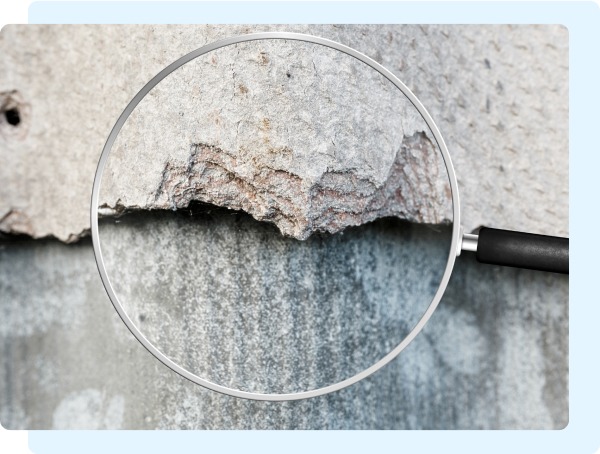If you have been diagnosed with Mesothelioma or Lung Cancer you could be entitled to significant compensation from both the Asbestos Trust Funds and asbestos product manufactures.
Contact us now for a FREE consultation.




Free Case Review
If you have been diagnosed with Mesothelioma or Lung Cancer you could be entitled to significant compensation from both the Asbestos Trust Funds and asbestos product manufactures.
Contact us now for a FREE consultation.



Free Case Review
Asbestos is a natural mineral, or more specifically, a group of minerals. They’re made up of fine, durable fibers that were once widely used.
Asbestos became a popular material in building products like insulation, roofing, and floor tiles, as well as automotive parts and textiles.
However, over time, it became clear that asbestos poses serious health risks when the fibers are inhaled or ingested. Prolonged exposure has the potential to cause deadly diseases, including mesothelioma, lung cancer, and asbestosis.
Despite its dangers, asbestos was widely used throughout the 20th century, and many older buildings still contain asbestos materials.
Understanding asbestos, the risks associated with exposure, and how to prevent harm is critical for those who work with or live in older buildings.

Asbestos is a naturally occurring group of minerals. Its microscopic fibers are strong, flexible, and resistant to heat, fire, and chemical damage.
These unique properties make it an attractive material for use in a wide range of industries, particularly construction, manufacturing, and shipbuilding.
Asbestos was commonly incorporated into building materials like insulation, roofing, floor tiles, cement, and pipes, as well as auto parts like brake pads and clutches.
For much of the 20th century, asbestos was hailed as a “miracle material” due to its effectiveness in protecting against heat and fire. It was widely used in homes, commercial buildings, schools, and even military ships.
However, despite its usefulness, it was later discovered that the very properties that made asbestos valuable also made it dangerous.
When asbestos-containing materials are disturbed—such as during construction, renovation, or demolition—tiny asbestos fibers can become airborne. When inhaled or ingested, these fibers pose serious health risks.
Asbestos exposure is now linked to a range of devastating diseases, including mesothelioma, a rare form of cancer that affects the lining of the lungs, as well as the abdomen or heart. Exposure is also linked to lung cancer and asbestosis.
Asbestosis is a chronic lung condition caused by scarring of lung tissue.
Because of the severe health risks of asbestos disease, its use has been heavily regulated and banned in many countries.
However, buildings and products containing asbestos can still pose risks if they release asbestos fibers.
Understanding what asbestos is, how it can be found, and the potential dangers it presents is crucial for protecting your health.
Asbestos is a group of minerals composed of fine, flexible fibers that are resistant to heat, fire, and chemical damage.
These unique properties made asbestos an ideal material for various industries, particularly in construction, manufacturing, and shipbuilding.
The mineral is typically divided into six types, each with its own characteristics: chrysotile (the most common), amosite, crocidolite, tremolite, anthophyllite, and actinolite.
The key properties of asbestos—durability, heat resistance, and fireproofing—made it extremely valuable for a wide range of applications.
Asbestos fibers are strong and resistant to breaking, making them ideal for reinforcing materials. This resistance to heat and fire was especially sought after for insulating buildings, boilers, pipes, and electrical components, as well as for use in fire-resistant fabrics and coatings.
Because of these attributes, asbestos was widely incorporated into construction materials like roofing shingles, insulation, flooring tiles, and cement products, as well as industrial products such as brake pads and gaskets.
Although asbestos has been used for thousands of years, its widespread commercial use began in the late 19th and early 20th centuries.
During this time, companies used asbestos more heavily, especially in industries like construction and shipbuilding, due to its cost-effectiveness and superior protective qualities. Asbestos became a staple material, particularly after World War I when its demand surged for insulation and fireproofing in buildings, ships, and vehicles.
Unfortunately, the properties that made asbestos so useful also contributed to its dangers. When they’re disturbed, asbestos fibers can become airborne and be inhaled, and exposure may lead to serious health conditions like mesothelioma, lung cancer, and asbestosis.
Despite its history as a “miracle material,” its hazardous health effects are now well-documented, and its use and manufacture by asbestos companies have been severely restricted in many countries.

Asbestos is not a single mineral but a group of six naturally occurring minerals that share similar properties but differ in appearance, structure, and specific uses.
Each type has characteristics that make it suitable for specific industrial and commercial applications.
Chrysotile asbestos, commonly known as white asbestos, is the most widely used form of asbestos, accounting for about 95% of the material used in the United States and globally.
Chrysotile fibers are curly and flexible, making them suitable for use in products needing flexibility and durability. They have been used extensively in insulation, roofing materials, floor tiles, brake linings, and gaskets.
Chrysotile was particularly favored for its heat-resistant properties and was commonly used in residential and commercial buildings.
Amosite asbestos, also known as brown asbestos, is one of the more dangerous types due to its straight, needle-like fibers.
When disturbed, these fibers are more likely to break into smaller, harmful particles.
Amosite was commonly used in insulation materials, cement products, and fire-resistant textiles. It was particularly favored in construction and manufacturing for its high tensile strength and also heat resistance.
Amosite is often found in older buildings, particularly in thermal insulation and spray-on fireproofing materials.
Crocidolite asbestos, also known as blue asbestos, is one of the most hazardous and harmful forms of asbestos. Its fibers are sharp, straight, and very fine, making them easily inhaled and extremely dangerous to health.
Crocidolite was primarily used in insulation materials, cement products, and plastics. It was also used in some types of gaskets and heat-resistant fabrics.
Though its use was largely phased out due to its high toxicity, crocidolite was once used in various applications where superior heat resistance was required.
Anthophyllite is a rarer type of asbestos, often found in insulating materials, ceramics, and paints.
While it was not used as extensively as chrysotile or amosite, it has still been identified in some asbestos-containing products.
Tremolite asbestos was primarily found as a contaminant in other asbestos types and was often used in insulating materials and paint products.
It was not intentionally mined for industrial use but has been detected in building materials and insulation products.
Like tremolite, actinolite was rarely used directly in products but can still be found as a contaminant in some asbestos-containing materials, particularly in insulation and cement products.
Its fibers are also hazardous and can pose serious health risks when inhaled.
Due to its unique properties, each type of asbestos was used in various applications, ranging from insulation and fireproofing to automotive components and construction materials.
However, all forms of asbestos pose significant health risks when their fibers are inhaled or ingested, leading to serious conditions like mesothelioma, lung cancer, and asbestosis.
Asbestos poses severe health risks when its microscopic fibers are inhaled or ingested.
Once these are airborne, they can be easily inhaled, or a person can swallow asbestos during activities like construction, demolition, or even everyday tasks in buildings containing asbestos materials.
The fibers are small enough to bypass the body’s natural defense mechanisms, settling in the lungs or other parts of the body, where they can cause significant damage over time.
Once the fibers are trapped in the lungs, the body cannot easily remove them, and as they accumulate, they can lead to a variety of serious health issues and cause inflammation. Since the fibers can cause inflammation, they can then lead to mutations that cause cancer and other illnesses.
The level of exposure does play a role in the risks, as short-term exposure may be lower risk than long-term exposure. Even so, no level of asbestos exposure is safe, no matter how much exposure happens or how long it lasts. Below are the main diseases asbestos fibers can cause.
Asbestosis is a chronic lung disease caused by inhaling asbestos fibers, especially long-term exposure.
Over time, the fibers from asbestos exposure may cause scarring (fibrosis) of the lung tissue, making it more challenging for the lungs to expand and contract properly.
Asbestosis can lead to shortness of breath, a persistent cough, and severe respiratory issues. It can also increase the risk of developing lung cancer. While asbestosis is not cancerous, the scarring of lung tissue can lead to permanent damage and impaired lung function.
Mesothelioma is a rare and aggressive cancer that impacts the lining of the lungs (pleural mesothelioma) or the abdomen (peritoneal mesothelioma).
The disease is almost exclusively caused by asbestos exposure, and it often does not manifest until 20 to 50 years after exposure.
Mesothelioma symptoms include chest pain, difficulty breathing, and unexplained weight loss, frequently occurring only when the disease has reached an advanced stage, which makes it difficult to treat effectively.
Lung cancer is another one of the serious health problems directly linked to asbestos exposure and the asbestos industry. Asbestos fibers can irritate the lungs, leading to the development of cancerous cells.
The potential risk of developing lung cancer is quite a bit higher for individuals who have been exposed to asbestos, especially for smokers.
Symptoms of lung cancer include:
Persistent coughing
Chest pain
Hoarseness
Difficulty breathing.
Pleural thickening is when the lining of the lungs (the pleura) becomes thickened and scarred due to asbestos exposure.
The condition can lead to difficulty breathing, chest pain, and reduced lung capacity.
While pleural thickening itself is not cancerous, it can be an indication of other asbestos-related diseases, including mesothelioma.
If you or someone you know has been exposed to asbestos, it’s important to be aware of potential symptoms, which can include:
Shortness of breath
Chest pain
Cough
Fatigue
In cases of mesothelioma and lung cancer, unexplained weight loss and hoarseness may also occur.
If any of these symptoms are present, especially in individuals with a history of asbestos exposure, it is essential to get medical attention for diagnosis and potential treatment.
Early detection helps manage symptoms and improve outcomes in cases of asbestos-related diseases.
Although exposure to asbestos can affect anyone, certain groups of people are at a much higher risk due to their work environments or living conditions.
Due to the nature of the work and the materials used, some occupations have a significantly higher risk of asbestos exposure.
These include:
Asbestos is commonly used in building materials like asbestos insulation, flooring, and roofing products. Workers who were involved in construction, demolition, or renovation projects before the 1980s are at a high risk of inhaling asbestos fibers.
Asbestos was widely used in the shipbuilding industry for insulation and fireproofing. Shipbuilders who work with asbestos-containing materials in ships’ engines, pipes, and boilers face an elevated risk.
Auto mechanics, especially those working with older vehicles, are at risk from asbestos found in brake pads, clutches, and gaskets. When these parts are handled or replaced, asbestos fibers can be released into the air.
Additionally, those who worked in asbestos mining are also considered high risk. Mining asbestos was common before most countries banned the use of asbestos.
Buildings constructed before the 1980s are more likely to contain legacy asbestos materials that can cause cancer. This includes homes, schools, and other public buildings where asbestos was used in insulation, roofing, floor tiles, and cement products.
Renovations or repairs in these older buildings can disturb asbestos and release harmful fibers into the air, putting those who live, work, or attend school in these buildings at risk.
In addition to direct exposure in the workplace, secondary exposure is a significant concern for the families of workers who handle asbestos.
Asbestos fibers can cling to clothing, shoes, and tools that workers may bring home after a long day. Family members—especially children and spouses—can inhale these fibers when they come into contact with contaminated clothing or surfaces.
This secondary exposure can also lead to serious health issues, including mesothelioma and lung cancer.
If you have been in any of these high-risk environments or have a history of secondary exposure, it’s important to monitor for symptoms.
As awareness of the risks associated with asbestos exposure grew, countries around the world began enacting regulations limiting the use or banning it.
These regulations have evolved over the years in response to mounting evidence of asbestos’s deadly effects, including lung cancer, mesothelioma, and asbestosis.
However, while many countries have taken significant steps to restrict asbestos use, some still use it in certain industries, creating potential health risks for workers and the public.
The first major regulatory step was taken in the 1970s when the United States and several other countries recognized the dangers of asbestos exposure.
In 1971, the Occupational Safety and Health Administration (OSHA) in the U.S. set the first permissible exposure limits (PELs) for asbestos in the workplace.
This was followed by the Environmental Protection Agency (EPA) banning certain asbestos-containing products in the late 1970s.
Countries like the United Kingdom and Australia implemented their own regulations to protect workers from asbestos exposure.
In 1989, the EPA attempted to ban all asbestos-containing products in the U.S. through the Asbestos Ban and Phase-Out Rule, but the decision was overturned in 1991 after legal challenges. Despite this setback, other countries, particularly in Europe, began enacting broader bans.
The use of asbestos in the U.S. has been heavily restricted. Some products, such as asbestos-containing gaskets, brake pads, and roofing materials, are still allowed under limited circumstances. However, the U.S. continues to import and use small amounts of asbestos, and the EPA has been working to increase regulatory oversight of asbestos-containing products.
The European Union is among the strictest regions regarding asbestos regulation. In 2005, all forms of asbestos, including its use in manufacturing and its presence in building materials, were banned across EU member states.
Many countries, including Australia, Canada, and Japan, have enacted complete bans on asbestos. Australia, for instance, banned the mining, use, and importation of asbestos in 2003. Canada followed suit in 2018 with a nationwide ban on importing and manufacturing asbestos.
While many countries have comprehensive bans on asbestos, loopholes still exist that allow limited use in certain industries.
Additionally, the asbestos removal process in older buildings and infrastructure is costly, leading to debates about continued use in specific applications. Some developing countries with less stringent regulations still permit the use of asbestos in construction materials.
These loopholes underscore the need for continued vigilance in asbestos regulation.
Many older homes, schools, workplaces, and commercial buildings may still contain asbestos-containing materials (ACMs). Identifying these materials is crucial for your safety, as asbestos exposure can lead to severe health conditions like mesothelioma, lung cancer, and asbestosis.
Asbestos was commonly used in a variety of construction materials, especially before the 1980s.
Some of the most common ACMs include:
Asbestos was used in thermal insulation products, including pipe insulation, attic insulation, and wall insulation, especially in homes and commercial buildings constructed before the 1980s.
Vinyl floor tiles, especially those manufactured before the 1980s, often contained asbestos, and the adhesive used to install them may also contain asbestos.
Asbestos was a key component of roofing materials such as shingles, roofing felt, and cement, particularly in homes built between the 1940s and 1970s.
Asbestos was added to cement products like siding, roofing, and pipes to enhance their durability and resistance to heat.
Asbestos was used in fire-resistant fabrics, such as blankets, protective clothing, and fireproof curtains
If your building was constructed before the 1980s, there’s a good chance it may contain asbestos. Some common signs that asbestos may be present include:
Aged and deteriorating materials: Asbestos is most dangerous when the material containing it becomes damaged or deteriorates. This includes broken tiles, crumbling insulation, or old roofing materials.
Buildings from the 1940s to 1970s: Homes and commercial buildings built during this period are most likely to contain asbestos-containing products.
Asbestos fibers become dangerous when they are airborne and inhaled, which can happen if the material is cut, drilled, or damaged.
Removing asbestos yourself can increase the risk of exposure to you and others in the area. It’s essential to hire a certified asbestos professional to assess the material, perform proper testing, and safely remove or contain it if necessary. These professionals are trained to handle asbestos and ensure the area remains safe during the process.
Asbestos testing helps identify whether harmful fibers are present and determines the level of risk. Licensed professionals should always conduct testing and removal to ensure safety and compliance with local regulations.
There are several methods used to test for asbestos presence in a building or material:
Air sampling is one of the most common methods for detecting airborne asbestos fibers. This process involves collecting air samples from an area suspected to be contaminated with asbestos. The samples are then analyzed in a laboratory to determine the concentration of asbestos fibers in the air.
In bulk material analysis, a sample of the material suspected to contain asbestos (such as insulation, tiles, or ceiling materials) is carefully collected and sent to a certified laboratory for examination. The lab will analyze the material under a microscope to determine if asbestos fibers are present and identify the type of asbestos.
Professional asbestos removal, or abatement, is the process of safely removing asbestos-containing materials from a building.
The steps involved in this process include:
Before any work begins, the area is sealed off to prevent the spread of asbestos fibers. This may include erecting barriers, setting up containment units, and controlling airflow to keep the asbestos from reaching other parts of the building.
Abatement professionals wear specialized PPE, including respirators, protective suits, gloves, and goggles, so workers are not exposed to dangerous asbestos fibers during the removal process.
Asbestos-containing materials must be disposed of according to strict guidelines. The materials are sealed in secure, labeled containers to prevent the release of asbestos fibers during transport. These containers are then taken to a certified landfill licensed to handle hazardous waste.
Asbestos abatement is a specialized process that requires proper training, experience, and equipment to protect both workers and the public.
Hiring a licensed professional ensures that the testing, removal, and disposal of asbestos are done safely and in compliance with all regulations.
Untrained individuals handling asbestos can increase the risk of contamination and exposure. Always hire a certified asbestos removal expert,
Those diagnosed with asbestos-related diseases, such as mesothelioma, lung cancer, and asbestosis, may be eligible for compensation to help cover medical expenses, lost wages, pain and suffering, and other costs related to their illness.
Victims can pursue compensation through several legal avenues, including:
Asbestos trust funds
Lawsuits
Settlements.
Asbestos trust funds were established by companies that were held responsible for asbestos-related diseases but filed for bankruptcy due to the overwhelming number of lawsuits.
These companies created trust funds to ensure compensation for individuals harmed by their asbestos products, even as they went through the bankruptcy process.
The creation of these trust funds protected asbestos victims by providing a mechanism for claiming compensation, even when the companies responsible for their exposure no longer existed or were financially incapable of paying out damages.
As of recent estimates, over $30 billion remains in these trust funds, available to individuals who have been diagnosed with asbestos-related diseases.
There are two ways to seek compensation for asbestos-related diseases:
Individuals who have been exposed to asbestos may file lawsuits against the companies that manufacture or use asbestos-containing products.
These companies are often held liable for failing to protect workers or the public from exposure.
Filing a lawsuit can result in a significant financial award if the case goes to trial and a verdict is rendered in the victim’s favor.
Many asbestos lawsuits are resolved through settlements.
In a settlement, the defendant agrees to pay the victim a lump sum in exchange for resolving the case without going to trial. Settlements are often faster and more predictable than trial verdicts.
However, if a settlement is not reached, the case may proceed to trial. Then, a judge or jury will decide the outcome. Victims who win their case in court may receive higher compensation amounts through trial verdicts.

To determine eligibility for compensation, the following steps should be taken:
Document the circumstances of asbestos exposure, including the type of materials involved, the duration of exposure, and the places or industries where exposure occurred. Victims should gather employment records, medical records, and any evidence of asbestos-related illnesses.
Contact a lawyer with experience in handling asbestos-related claims. A qualified attorney will assess the case, help navigate the legal process, and identify which legal avenues to pursue for compensation.
Once eligibility is determined, a claim can be filed with an asbestos trust fund, or a lawsuit can be initiated against the responsible parties. The attorney will assist in ensuring all necessary documentation and deadlines are met.
Victims of asbestos-related diseases should take immediate action to explore their legal options for compensation, as timely filing is crucial to securing the compensation they deserve.

Although asbestos use has been heavily restricted in many countries, it still exists in buildings, homes, and products constructed prior to its ban.
Here are several ways to prevent asbestos exposure and protect yourself and others from its harmful effects.
If you live or work in a building constructed before the 1980s, it’s crucial not to disturb any materials that may contain asbestos.
This includes insulation, ceiling tiles, floor tiles, and roofing materials.
Disturbing these materials—by drilling, cutting, or sanding can release dangerous asbestos fibers into the air, which can then be inhaled.
Always leave potential asbestos-containing materials undisturbed unless professionally tested and confirmed safe.
If you own or manage older properties, conduct regular inspections to check for the presence of asbestos.
Professional asbestos inspectors can identify materials that may contain asbestos and assess their condition. If any materials are found to be deteriorating, they should be addressed immediately by licensed professionals.
Workers in high-risk professions—such as construction, shipbuilding, and demolition—should always wear appropriate personal protective equipment (PPE), including respirators, protective suits, gloves, and goggles.
This equipment helps prevent the inhalation of asbestos fibers.
Employers in high-risk industries are required to follow strict safety regulations to protect their workers
Increasing public awareness and education about the risks of asbestos exposure is essential to prevent future cases of asbestos-related diseases.
Awareness programs in schools, workplaces, and communities are vital to ensuring safety for those in high-risk environments.
By following these safety measures and increasing awareness, individuals can reduce their risk of asbestos exposure and protect their health, especially in older buildings or high-risk professions.
Failure to warn claims are negligence (a lack of care) claims. Defective product claims are strict liability claims. Manufacturers are liable for damages as a matter of law if a manufacturing or design defect causes injury.
Asbestos insulation and other such products have design defects. The asbestos shouldn’t have been part of the design. Asbestos-laced products, like asbestos-laced talcum powder, have manufacturing defects. The company didn’t do enough to protect consumers from cross-contamination poisoning.

A non-legal option may be available as well. When the asbestos cover-up began unraveling in the early 1980s and victims started filing lawsuits, many asbestos companies took the easy way out and declared bankruptcy.
As a condition of these bankruptcies, federal judges ordered these companies to establish victim compensation funds. Even today, some forty years later, these funds still contain an estimated $30 billion.

Therefore, most claims don’t settle until mediation. This stage follows discovery, which is an evidence exchange phase. Two of the most important pieces of evidence are the client’s affidavit of exposure and deposition. Once these two pieces of the puzzle are in place, the case moves very quickly, especially if the patient is alive.
When the judge appoints a third-party mediator to oversee negotiations, the judge adds a good faith negotiation duty, which was mentioned above. Low-ball offers aren’t good faith offers.

While the use of asbestos has been largely restricted, it is still present in some industrial applications where safer alternatives are not feasible.
Because of its heat resistance and durability, asbestos is sometimes used in brake linings, gaskets, and certain roofing materials. However, these uses are heavily regulated, and safer alternatives are generally encouraged.
Asbestos is not completely banned in the U.S., though its use is heavily restricted. The EPA regulates asbestos-containing materials, and certain products that still contain asbestos, like brake pads and roofing materials, are allowed under strict guidelines.
Efforts to implement a full ban continue, but loopholes exist that permit limited use of asbestos in certain industries.
If you’ve worked in a high-risk occupation or lived in an older building, there’s a chance you’ve been exposed to asbestos.
Common symptoms of asbestos-related diseases include shortness of breath, chronic coughing, chest pain, and fatigue.
It’s important to consult a doctor if you experience any of these symptoms, especially if you have a history of asbestos exposure. Early detection is crucial for managing asbestos-related diseases.
Yes, asbestos can be safely removed, but only by licensed professionals trained in asbestos abatement.
The removal process involves sealing off the area, using protective equipment, and safely disposing of the material to prevent fiber release.
DIY removal is dangerous and can lead to exposure to harmful asbestos fibers.
To file a claim for asbestos-related diseases, the first step is to consult with an attorney who specializes in asbestos litigation.
Your attorney will help gather necessary documents, such as employment records and medical history, to prove exposure.
From there, a claim can be filed either through asbestos trust funds or by pursuing a lawsuit against the responsible parties. Your attorney will guide you through each step, ensuring you meet all deadlines and legal requirements.
If you or someone you know has been diagnosed with mesothelioma due to asbestos exposure, don’t wait to take legal action. Our experienced attorneys are here to help you navigate the legal process, fight for your rights, and secure the compensation you deserve.
We work on a contingency fee basis, meaning you have no upfront costs that come with your mesothelioma claims.
We don’t get paid unless we win your case and receive compensation.
Fill out the form below and get your free case review